Key Takeaways of How to Set Up an Interview
- Streamline your interview process: Enhance candidate experiences and make informed hiring decisions by following a structured approach to setting up interviews as a recruiter.
- Foster effective communication: Maintain clear and prompt communication with candidates, interviewers, and panel members throughout the interview process to ensure a seamless experience.
- Optimize candidate evaluation: Create comprehensive interview materials, provide interview support, and offer constructive feedback to candidates, maximizing the effectiveness of your recruitment strategy.
As a recruiter, the success of your hiring process hinges on your ability to effectively set up interviews.
It’s the crucial phase where you lay the foundation for a positive candidate experience, evaluate potential hires, and ultimately select the best fit for the position.
However, interview setup can be a complex and demanding task, requiring meticulous planning, excellent communication skills, and a knack for organization.
“The Ultimate Guide: How to Set Up an Interview as a Recruiter” is here to equip you with the knowledge and tools necessary to navigate this critical phase of the recruitment process successfully.
Whether you’re a seasoned recruiter looking to refine your techniques or a new professional eager to learn the ropes, this comprehensive guide will provide you with valuable insights and practical strategies to streamline your interview setup process.
In this guide, we will walk you through every step of setting up interviews as a recruiter, from initial preparation to follow-up and feedback.
We’ll explore the key factors that contribute to a seamless interview process, including scheduling, communication, logistics, interviewer coordination, interview materials, and more.
By the end of this guide, you’ll have a solid understanding of the best practices and actionable tips that will help you optimize your interview setup process and deliver exceptional candidate experiences.
To kickstart your journey, we’ll begin with the crucial aspect of preparing for the interview setup.
Understanding the job requirements and candidate profile is paramount to tailor the interview process effectively.
We’ll delve into strategies for gathering the necessary information, defining the interview stages, and ensuring you have all the elements in place for a successful interview session.
Once the groundwork is laid, we’ll move on to scheduling the interview.
We’ll discuss how to choose the ideal interview date and time, ensuring that it accommodates both the candidate’s and interviewer’s availability.
Additionally, we’ll explore the benefits of utilizing scheduling tools and software to automate and streamline this process, saving you valuable time and effort.
Of course, effective communication with candidates is paramount throughout the interview setup process.
We’ll provide you with invaluable tips for crafting professional interview invitations and confirmations, ensuring that candidates are well-informed about the interview details and logistics.
Moreover, we’ll address the importance of offering support and promptly addressing any queries or concerns candidates may have, fostering a positive and engaging candidate experience.
As you progress, we’ll dive into the intricacies of arranging the interview logistics.
Whether you’re coordinating in-person, phone, or video interviews, we’ll guide you through the selection of the most appropriate format and provide insights on booking interview rooms or setting up virtual meeting platforms.
Additionally, we’ll explore the technical considerations for remote interviews, ensuring a smooth and glitch-free experience for both candidates and interviewers.
A successful interview setup also relies on seamless coordination with interviewers and panel members.
We’ll discuss effective strategies for informing interviewers about the interview schedule and logistics, sharing candidate profiles and interview questions, and managing any potential schedule conflicts.
With our guidance, you’ll be able to facilitate effective collaboration and ensure that all interviewers are aligned and prepared to evaluate candidates.
The next phase of our guide focuses on preparing interview materials, which are essential for a structured and productive interview.
We’ll help you create comprehensive interview agendas and timelines, compile candidate resumes and application materials, and share relevant documents with interviewers.
With these preparations in place, you’ll be able to facilitate a focused and insightful interview session.
Beyond the setup, we recognize the importance of providing support to candidates throughout their interview journey.
We’ll explore ways to assist candidates with interview preparation resources, address their concerns or special accommodations, and offer guidance on interview etiquette and expectations.
By creating a supportive environment, you’ll empower candidates to perform at their best and make informed decisions about their fit with your organization.
The interview setup process doesn’t end when the interviews conclude.
We’ll guide you through the critical steps of follow-up and feedback.
We’ll explore effective methods for collecting interviewer feedback and evaluations, as well as sharing constructive feedback with candidates in a timely manner.
By maintaining open lines of communication, you’ll strengthen your employer brand and nurture positive candidate relationships.
“The Ultimate Guide: How to Set Up an Interview as a Recruiter” is your go-to resource for mastering the art of seamless candidate engagement.
By implementing the strategies and insights shared in this guide, you’ll be equipped to optimize your interview setup process, enhance candidate experiences, and ultimately make well-informed hiring decisions.
Get ready to revolutionize your interview setup process. Let’s embark on this transformative journey together and unlock the potential for recruitment excellence.
Before we venture further into this article, we like to share who we are and what we do.
About 9cv9
9cv9 is a business tech startup based in Singapore and Vietnam, with a strong presence all over the world.
With over six years of startup and business experience, and being highly involved in connecting with thousands of companies and startups, the 9cv9 team has listed some important learning points in this overview of the guide on how to set up the best interview conditions for your candidates.
If your company needs recruitment and headhunting services to hire top-quality employees, you can use 9cv9 headhunting and recruitment services to hire top talents and candidates. Find out more here, or send over an email to [email protected].
Or just post 1 free job posting here at 9cv9 Hiring Portal in under 10 minutes.
How to Set Up an Interview as a Recruiter: The Ultimate Guide
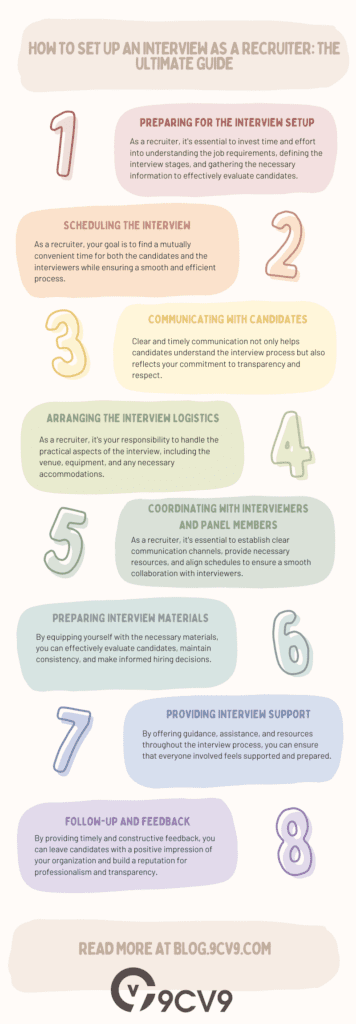
- Preparing for the Interview Setup
- Scheduling the Interview
- Communicating with Candidates
- Arranging the Interview Logistics
- Coordinating with Interviewers and Panel Members
- Preparing Interview Materials
- Providing Interview Support
- Follow-up and Feedback
1. Preparing for the Interview Setup
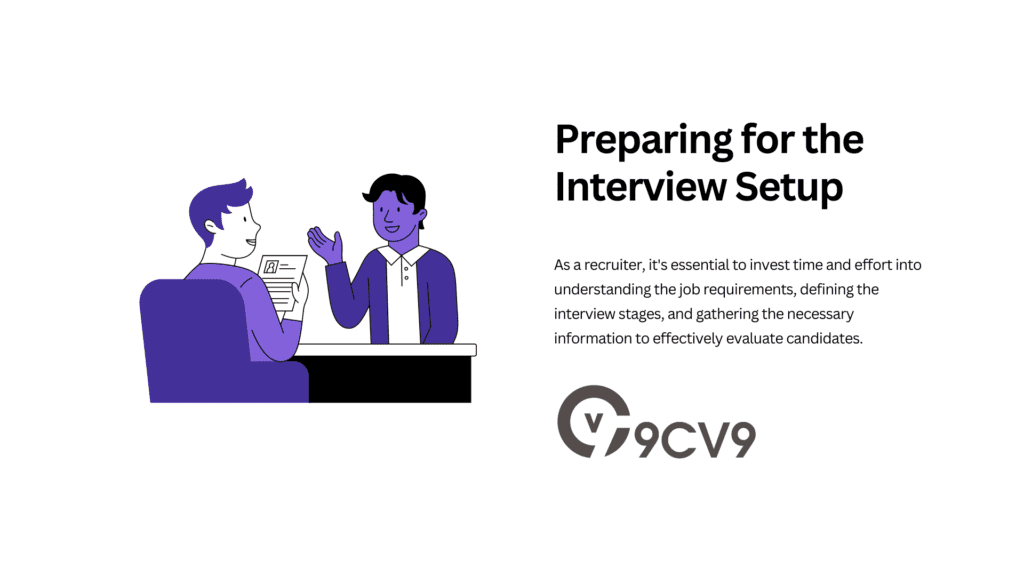
Preparing for the interview setup is a crucial phase that lays the foundation for a smooth and successful interview process.
As a recruiter, it’s essential to invest time and effort into understanding the job requirements, defining the interview stages, and gathering the necessary information to effectively evaluate candidates.
In this section, we will explore the key steps involved in preparing for the interview setup and provide you with actionable tips and relevant examples to optimize your preparation process.
I. Understanding the Job Requirements and Candidate Profile
Before diving into the interview setup process, it’s vital to have a clear understanding of the job requirements and the ideal candidate profile.
Thoroughly reviewing the job description, qualifications, and desired skills will enable you to align your interview process with the specific needs of the position.
Here are a few strategies to help you in this stage:
- Review the job description and qualifications: Carefully analyze the job description to identify the primary responsibilities, required qualifications, and desired skills for the role. This will guide you in designing interview questions that assess candidates’ suitability for the position. Also, do have a read at our most popular guide: Mastering the Art of Writing Effective Job Descriptions: A Comprehensive Guide
Example: Suppose you’re hiring for a software developer role. The job description may highlight requirements such as proficiency in programming languages (e.g., Java, Python), experience with specific frameworks (e.g., Django, React), and understanding of software development methodologies (e.g., Agile). Understanding these requirements will help you tailor the interview process accordingly.
In fact, the 9cv9 Research Team has put together some of the top job description templates to hire top IT talents here. All our templates are SEO-optimised which means they are more likely to appear at the top of the search engine’s results.
- Consult with hiring managers and stakeholders: Collaborate with hiring managers and relevant stakeholders to gain insights into the position’s unique requirements and expectations. This collaboration ensures that the interview process aligns with the team’s needs and fosters a collaborative approach to candidate evaluation.
Example: If you’re hiring for a marketing manager position, consult with the marketing team to understand their specific goals, challenges, and desired qualifications. This collaboration will help you develop interview questions that assess a candidate’s ability to address the team’s marketing objectives effectively.
- Research the industry and competitors: Stay updated on industry trends and competitors to understand the evolving landscape and the skills in demand. This knowledge will enable you to assess candidates’ industry knowledge and their potential contributions to the organization. Or get the 9cv9 Research Team to help to provide some of the top HR and Hiring insights in the world.
Example: If you’re recruiting for a sales representative role in the e-commerce industry, research the latest sales strategies, customer acquisition techniques, and emerging technologies. This information will help you craft interview questions that assess a candidate’s familiarity with industry best practices and their ability to drive sales in a competitive market.
II. Defining the Interview Stages
Once you have a clear understanding of the job requirements, it’s time to define the interview stages that will allow you to assess candidates thoroughly.
A well-structured interview process provides consistency and enables fair evaluation.
Consider the following steps when defining the interview stages:
- Determine the interview format: Decide on the interview format(s) that best align with the position and your organization’s needs. Common formats include phone interviews, in-person interviews, and video interviews.
Example: For a remote position, you might opt for a combination of video interviews and phone screenings to assess a candidate’s communication skills and suitability for a virtual work environment.
Also read our top guide on “Efficient Communication For Remote Teams: Top 5 Useful and Quick Tools in 2023”.
- Plan the number of interview rounds: Determine the number of interview rounds required based on the complexity of the role and the organization’s hiring standards. Multiple rounds allow for a comprehensive evaluation and input from different stakeholders.
Example: A senior executive position may involve multiple interview rounds, such as an initial phone screening, followed by interviews with the hiring manager, and the executive team, and possibly a presentation or case study assessment.
- Identify the interviewers: Assign appropriate interviewers based on their expertise and the specific aspects they will evaluate. This may include hiring managers, team members, executives, or subject matter experts.
Example: When hiring for a product manager role, involve team members from different functional areas, such as engineering, marketing, and design, to assess a candidate’s ability to collaborate effectively across departments.
- Allocate time for each interview stage: Set a reasonable time frame for each interview stage to ensure efficient scheduling and avoid unnecessary delays. This will help maintain a positive candidate experience and demonstrate your organization’s professionalism.
Example: Allocate 30 minutes for a phone screening, 60 minutes for a technical interview, and 45 minutes for a cultural fit interview. Having predefined time frames will help you effectively manage the interview process.
III. Gathering Necessary Information for the Interview
To conduct an insightful interview, it’s important to gather all the necessary information about the candidates beforehand.
This includes reviewing their resumes, application materials, and any additional assessments they may have completed.
Consider the following steps when gathering candidate information:
- Review resumes and cover letters: Carefully go through the resumes and cover letters to familiarize yourself with the candidates’ educational background, work experience, achievements, and skills. Highlight relevant areas to inform your interview questions. If you need help, you can get UrbanCV‘s team to assist in all CV-related tasks.
Example: If a candidate mentions experience with project management software in their resume, you can ask specific questions during the interview to assess their proficiency in using such tools and managing projects.
- Assess additional materials: If candidates have submitted additional materials, such as portfolios, writing samples, or case studies, take the time to review them. These materials provide valuable insights into their abilities and achievements beyond what is reflected in their resumes.
Example: If a candidate includes a portfolio of their design work, review the samples to evaluate their creativity, attention to detail, and ability to translate concepts into visually appealing designs. This will help you tailor your interview questions to delve deeper into their design process.
- Consider pre-interview assessments: Some positions may require candidates to complete pre-interview assessments, such as coding tests or personality assessments. Review these assessments to gain a comprehensive understanding of candidates’ technical skills or personality traits before the interview.
Example: If candidates have completed a coding test, analyze their solutions to assess their problem-solving abilities, coding style, and adherence to best practices. Use this information to ask targeted questions during the interview, focusing on areas that require clarification or further exploration.
By investing time in understanding the job requirements, defining interview stages, and gathering necessary information, you’ll be well-prepared to conduct effective interviews and make informed hiring decisions.
The next step in the interview setup process is scheduling the interviews, which we will explore in the following section.
Stay tuned to learn valuable tips for seamless interview scheduling and coordination.
2. Scheduling the Interview
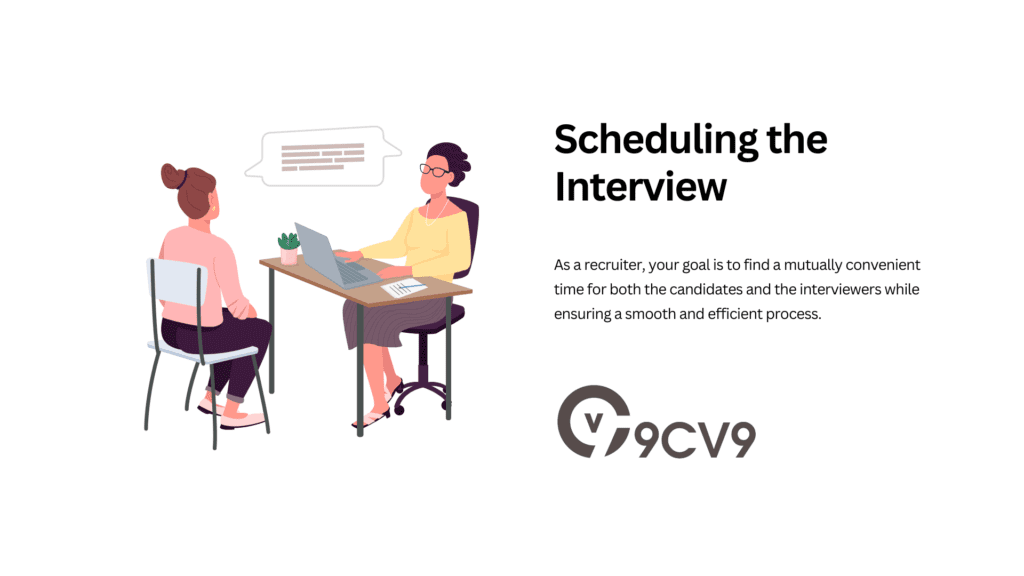
Scheduling the interview is a critical step in the recruitment process that requires careful coordination and consideration of various factors.
As a recruiter, your goal is to find a mutually convenient time for both the candidates and the interviewers while ensuring a smooth and efficient process.
In this section, we will explore effective strategies and provide actionable tips for scheduling interviews. Let’s dive in.
I. Choosing the Right Interview Date and Time
Selecting the appropriate interview date and time is crucial to accommodate both the availability of the candidates and the interviewers. Consider the following strategies to help you make the right choice:
- Flexible scheduling options: Offer candidates a range of time slots to choose from, including mornings, afternoons, or evenings. This flexibility increases the likelihood of finding a suitable time that works for everyone involved.
Example: Provide candidates with options such as morning slots (9 AM – 12 PM), afternoon slots (1 PM – 4 PM), or evening slots (5 PM – 8 PM). This allows candidates to select the time that aligns with their schedule, whether they have other commitments or prefer specific timeframes for optimal performance.
- Consider time zone differences: If you are scheduling interviews with candidates from different geographical locations, be mindful of time zone differences. Take into account the candidates’ local time to ensure that the interview is scheduled at a reasonable hour for them.
Example: If you’re based in New York and scheduling an interview with a candidate from London, consider their time zone and propose interview slots that align with their business hours, such as late morning or early afternoon in their local time.
- Plan buffer time between interviews: Allow sufficient buffer time between interviews to avoid overlapping schedules and provide interviewers with time to provide feedback or take necessary breaks. This buffer time ensures a smooth transition between interviews and allows interviewers to prepare adequately.
Example: If you schedule back-to-back interviews, allocate 15-30 minutes of buffer time to account for any potential delays, complete interview documentation, and prepare for the next interview.
II. Coordinating with Candidates and Other Stakeholders
Effectively coordinating with candidates and other stakeholders is key to ensuring a seamless interview scheduling process.
Employ the following strategies to streamline communication and coordination:
- Prompt communication: Respond to candidate communication promptly and maintain clear and transparent communication throughout the scheduling process. This demonstrates professionalism and helps build a positive candidate experience.
Example: When candidates express their availability or request rescheduling, respond within 24 hours, acknowledging their message and proposing alternative time slots or offering further assistance.
- Centralized scheduling system: Utilize a centralized scheduling system or software that allows candidates to view available interview slots and select their preferred time. This eliminates the back-and-forth communication and simplifies the scheduling process.
Example: Implement scheduling tools such as Calendly, Google Calendar, or applicant tracking systems (ATS) with built-in scheduling features. These tools enable candidates to see real-time availability and self-schedule interviews based on their convenience.
- Consider candidate preferences: Whenever possible, take into account candidate preferences for interview timing. This demonstrates respect for their schedules and helps create a positive candidate experience.
Example: During initial communication, ask candidates if they have any specific time constraints or preferences. If feasible, accommodate their preferences when scheduling interviews, considering factors such as their existing work schedule or personal commitments.
III. Utilizing Scheduling Tools and Software
Incorporating scheduling tools and software can significantly streamline the interview scheduling process, saving time and effort for both recruiters and candidates.
Here are a few tips for leveraging these tools effectively:
- Integrated calendar systems: Integrate your calendar system with scheduling tools to automatically update availability and avoid double bookings. This ensures that interview slots are accurately reflected and minimizes the chance of scheduling conflicts.
Example: If you use Google Calendar, sync it with your scheduling tool so that any appointments or commitments on your calendar are automatically blocked off in the scheduling tool’s available slots.
- Automated reminders: Set up automated email reminders for both candidates and interviewers to minimize the risk of missed or forgotten interviews. These reminders serve as a helpful nudge and reduce the likelihood of last-minute rescheduling.
Example: Configure your scheduling tool to send automated reminders to candidates and interviewers a day or two before the scheduled interview, including details such as the date, time, location (if applicable), and any specific instructions.
- Scheduling team availability: If you’re coordinating interviews with multiple interviewers, utilize scheduling tools that allow you to view their availability and find mutually convenient time slots. This streamlines the coordination process and reduces the need for extensive email exchanges.
Example: Tools like Doodle or When2Meet enable you to create a poll where interviewers can indicate their availability, making it easier to identify overlapping time slots that work for everyone involved.
By implementing these strategies and leveraging scheduling tools and software, you can streamline the interview scheduling process, save time, and provide a positive experience for both candidates and interviewers.
In the next section, we will delve into the importance of effective communication during the interview setup process.
Stay tuned for valuable tips on crafting professional interview invitations and confirmations.
3. Communicating with Candidates
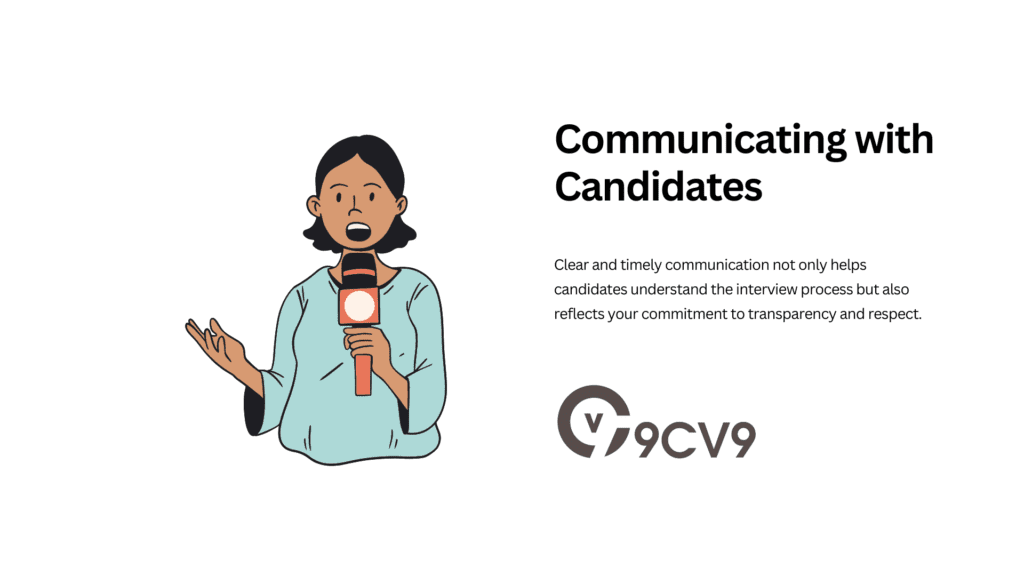
Effective communication with candidates throughout the interview setup process is essential for building a positive candidate experience and maintaining a professional image for your organization.
Clear and timely communication not only helps candidates understand the interview process but also reflects your commitment to transparency and respect.
In this section, we will explore the best practices for communicating with candidates and provide actionable tips to optimize your candidate communication strategy.
I. Crafting Professional Interview Invitations
The interview invitation sets the tone for the entire interview process and should be crafted with professionalism and clarity.
When sending interview invitations, consider the following strategies:
- Personalization: Personalize the interview invitation by addressing the candidate by their name and referring to the specific position they have applied for. This personal touch demonstrates attention to detail and shows that you value their application.
Example: “Dear [Candidate’s Name], We would like to invite you to interview for the position of [Job Title] at [Company Name].”
- Clear and concise information: Clearly communicate the essential details of the interview, including the date, time, and location (or interview format if it’s a virtual interview). Provide any additional instructions or materials candidates need to prepare for the interview.
Example: “The interview will take place on [Date] at [Time]. The interview will be conducted via [Video Conference Platform] and the meeting link will be shared with you separately. Please ensure you have a stable internet connection and a quiet environment for the interview.”
- Encourage confirmation and offer contact information: Encourage candidates to confirm their availability for the interview and provide a contact person or email address for any questions or concerns they may have. This promotes two-way communication and ensures that candidates feel supported throughout the process.
Example: “Please confirm your availability for the interview by replying to this email by [Date]. If you have any questions or need to reschedule, please feel free to contact our HR representative, [Name], at [Email Address] or [Phone Number].”
II. Prompt and Professional Responses
Timely and professional responses to candidate inquiries or requests for information are crucial for maintaining a positive candidate experience.
Consider the following strategies when communicating with candidates:
- Set clear response expectations: Clearly communicate the expected response time for candidate inquiries or requests. This manages candidate expectations and demonstrates your organization’s commitment to timely communication.
Example: “We strive to respond to all candidate inquiries within 24-48 hours. If you have any questions or need further clarification, we will make every effort to address them promptly.”
- Use professional and courteous language: Maintain a professional and courteous tone in all written communication with candidates. Use clear and concise language, avoid jargon, and be mindful of your tone to foster a positive and respectful impression.
Example: “Thank you for reaching out to us with your questions. We appreciate your interest in our company and the [Job Title] position. We are happy to provide you with the information you need.”
- Provide relevant information: Respond to candidate inquiries or requests with relevant and helpful information. Be proactive in addressing potential concerns or questions candidates may have regarding the interview process, compensation, benefits, or any other relevant topics.
Example: If a candidate asks about the interview format, respond with detailed information about the platform or technology used, any preparation materials they may need, and reassure them that technical support will be available if necessary.
III. Sending Interview Confirmations and Reminders
Sending interview confirmations and reminders helps candidates stay organized and ensures that they are well-prepared for their interviews.
Employ the following strategies when sending interview confirmations and reminders:
- Confirmation of interview details: Send a confirmation email to candidates once they have confirmed their availability, reiterating the interview details, including the date, time, location (or interview format), and any specific instructions or materials they need to bring.
Example: “Thank you for confirming your availability for the interview. We look forward to meeting you on [Date] at [Time]. The interview will be held at [Address], and please bring a copy of your resume and any other relevant documents.”
- Reminders closer to the interview date: Send a reminder email to candidates a day or two before the interview to ensure they are well-prepared and have the necessary information. Include any last-minute instructions or reminders they need to be aware of.
Example: “This is a friendly reminder that your interview for the position of [Job Title] is scheduled for [Date] at [Time]. Please make sure you have reviewed the job description and prepared any questions you may have for the interview. If you have any changes to your availability or need to reschedule, please contact us as soon as possible.”
- Provide contact information for assistance: Include contact information in the confirmation and reminder emails for candidates to reach out if they have any last-minute questions or concerns. This demonstrates your willingness to support candidates and ensures they feel comfortable seeking assistance.
Example: “If you have any questions or need any further assistance before the interview, please don’t hesitate to reach out to our HR representative, [Name], at [Email Address] or [Phone Number]. We are here to help.”
By implementing these strategies for effective candidate communication, you can create a positive candidate experience, build rapport, and establish your organization as professional and attentive.
In the next section, we will explore the key considerations for conducting successful interviews as a recruiter. Stay tuned for valuable insights and tips on conducting interviews that yield meaningful results.
4. Arranging the Interview Logistics
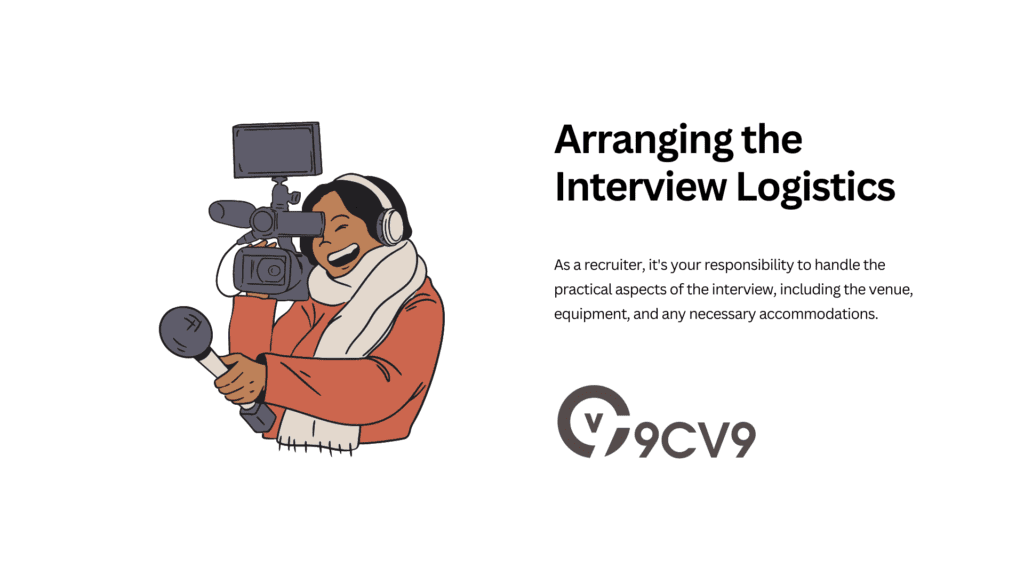
Arranging the interview logistics is a crucial step in the recruitment process that ensures a smooth and well-coordinated interview experience for both candidates and interviewers.
As a recruiter, it’s your responsibility to handle the practical aspects of the interview, including the venue, equipment, and any necessary accommodations.
In this section, we will delve into the key considerations and provide actionable tips for arranging the interview logistics effectively.
I. Selecting the Interview Format
With the rise of remote work and virtual interviews, choosing the appropriate interview format is essential.
Consider the following factors when deciding on the interview format:
- In-person interviews: In situations where the candidate and interviewers are in the same geographical location, in-person interviews can provide a more personal and interactive experience. Ensure that the interview venue is easily accessible, comfortable, and conducive to a professional environment.
Example: Reserve a conference room with adequate seating, good lighting, and minimal noise distractions. Consider factors such as parking availability and public transportation options for the convenience of both candidates and interviewers.
- Virtual interviews: Virtual interviews have become increasingly popular due to their convenience and ability to connect with candidates from different locations. When conducting virtual interviews, consider the technology platform, equipment, and internet connection to ensure a smooth and uninterrupted interview experience.
Example: Use video conferencing software such as Zoom, Microsoft Teams, or Google Meet. Test the technology in advance to ensure that both the interviewer and candidate have a stable internet connection and functioning audio and video equipment.
- Phone interviews: Phone interviews are often used as a preliminary screening tool or for remote candidates. While they lack visual cues, they are an efficient way to assess a candidate’s communication skills and initial fit for the role.
Example: Schedule a specific time for the phone interview and ensure that both parties have a quiet environment with minimal background noise. Prepare a list of questions in advance to maintain structure and focus during the interview.
II. Coordinating Interview Schedules
Coordinating interview schedules involves aligning the availability of candidates and interviewers to ensure a smooth and efficient process.
Consider the following strategies for effective schedule coordination:
- Establish a central point of contact: Designate a central point of contact, such as an HR representative or coordinator, to manage interview schedules. This individual can communicate with candidates and interviewers, coordinate availability, and handle any scheduling conflicts.
Example: Provide candidates with a specific contact person and their contact information for any scheduling-related inquiries or adjustments.
- Utilize scheduling tools or software: Leverage scheduling tools or applicant tracking systems (ATS) with built-in scheduling features to streamline the coordination process. These tools can display available time slots, send automated invitations, and handle rescheduling requests.
Example: Use scheduling tools like Calendly, Doodle, or the scheduling features within an ATS to simplify the scheduling process. Provide candidates with a link to the scheduling tool where they can select their preferred interview slot from the available options.
- Consider time zone differences: If scheduling interviews with candidates from different time zones, be mindful of the time zone differences to avoid scheduling conflicts. Adjust interview times accordingly to ensure both candidates and interviewers can participate comfortably.
Example: Use time zone conversion tools or scheduling software that automatically adjusts for time zone differences. Clearly communicate the interview time in the candidate’s local time to avoid confusion.
III. Providing Accommodations and Instructions
To ensure a comfortable and inclusive interview experience, it’s important to provide necessary accommodations and clear instructions to both candidates and interviewers.
Consider the following factors when arranging interview logistics:
- Accommodations for candidates: Inquire about any specific accommodations that candidates may require, such as accessibility needs, language interpretation, or other special requirements. Make the necessary arrangements to accommodate these requests to create an inclusive and equitable interview environment.
Example: If a candidate requires wheelchair accessibility, ensure that the interview venue has wheelchair ramps and accessible restrooms. If language interpretation is needed, arrange for a qualified interpreter to be present during the interview.
- Interviewer instructions and materials: Provide interviewers with detailed instructions and any relevant materials they need for the interview. This ensures consistency and preparedness among interviewers and helps maintain a structured and fair interview process.
Example: Send interviewers a comprehensive interview guide that includes the interview format, a list of interview questions, evaluation criteria, and any specific instructions or notes about the candidates they will be interviewing.
- Clear communication of logistics: Communicate the interview logistics clearly to both candidates and interviewers. Include all relevant details, such as the date, time, interview format, location (if applicable), and any additional instructions or requirements.
Example: Send a detailed email to all parties involved, clearly outlining the logistics of the interview, including the interview format, date, time, and any specific instructions or materials candidates need to prepare. Include a map or directions to the interview location, if applicable.
By considering these factors and effectively arranging the interview logistics, you can ensure a seamless and well-organized interview experience for both candidates and interviewers.
In the next section, we will discuss the importance of preparing for the interview as a recruiter and provide valuable tips to optimize your preparation process.
Stay tuned for insights and strategies to conduct successful interviews.
5. Coordinating with Interviewers and Panel Members
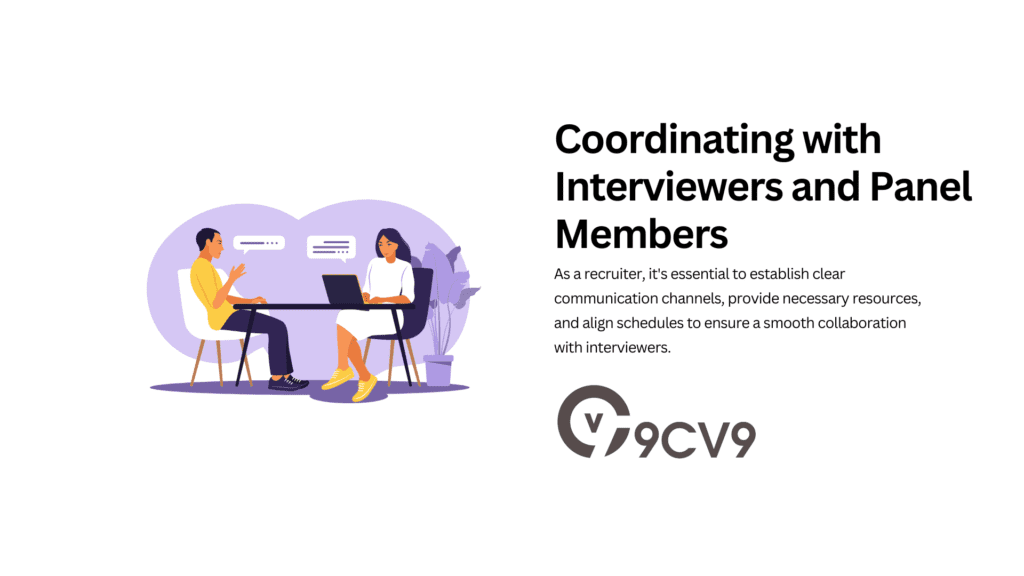
Coordinating with interviewers and panel members is a critical aspect of the interview process that ensures a well-organized and efficient evaluation of candidates.
As a recruiter, it’s essential to establish clear communication channels, provide necessary resources, and align schedules to ensure a smooth collaboration with interviewers.
In this section, we will explore effective strategies for coordinating with interviewers and panel members, enabling you to conduct successful interviews and make informed hiring decisions.
I. Establishing Communication Channels
Establishing clear and efficient communication channels with interviewers and panel members is vital for effective coordination.
Consider the following strategies:
- Centralized communication platform: Set up a centralized platform, such as an email thread or a dedicated collaboration tool, where all communication related to the interview process can take place. This ensures that everyone involved has access to relevant information and can stay updated on any changes or updates.
Example: Create a shared email thread or utilize collaboration tools like Slack or Microsoft Teams to facilitate ongoing communication and provide a space for discussion, sharing feedback, and addressing any queries or concerns.
- Regular communication updates: Provide regular updates to interviewers and panel members regarding the interview schedule, candidate profiles, and any specific instructions or materials they may need. This keeps everyone informed and ensures that they are prepared for their respective roles.
Example: Send a weekly update email summarizing the upcoming interviews, including the candidates’ names, interview time slots, and any relevant attachments or instructions. Encourage interviewers to reach out if they have any questions or require further information.
- Responsive communication: Be responsive to interviewers’ inquiries and requests for information. Timely communication helps maintain a positive working relationship, demonstrates professionalism, and ensures that interviewers feel supported throughout the process.
Example: Aim to respond to interviewers’ emails or messages within 24 hours, even if it’s just to acknowledge receipt of their message and provide a timeline for a more detailed response. Promptly address any concerns or questions they may have to facilitate a smooth interview experience.
II. Providing Interviewer Resources and Guidance
Equipping interviewers and panel members with the necessary resources and guidance is crucial for conducting effective interviews and ensuring a fair evaluation of candidates.
Consider the following strategies:
- Interviewer training and guidelines: Provide interviewers with comprehensive training and guidelines to ensure consistency and fairness in the evaluation process. This includes outlining the interview structure, highlighting the evaluation criteria, and offering tips for conducting meaningful interviews.
Example: Develop an interviewer training program that covers topics such as effective questioning techniques, active listening skills, evaluating candidate responses, and avoiding bias. Provide interviewers with a document outlining the interview process and the desired attributes and competencies for the role.
- Candidate information and profiles: Share relevant information about the candidates with the interviewers and panel members in advance. This allows them to familiarize themselves with the candidates’ backgrounds, skills, and experiences, enabling a more targeted and insightful interview.
Example: Create a candidate profile document that includes the candidate’s resume, cover letter, and any additional materials they submitted during the application process. Provide interviewers with access to this document or share it via the centralized communication platform.
- Sample interview questions: Offer a set of sample interview questions to guide interviewers and panel members during the interview. These questions serve as a starting point for discussion and help ensure that important areas are covered consistently across interviews.
Example: Prepare a list of behavioral, situational, and technical questions that align with the job requirements and the desired competencies. Share these sample questions with interviewers, emphasizing the importance of tailoring them to each candidate’s unique background and experience.
III. Coordinating Interviewer Availability and Schedule
Coordinating interviewer availability and aligning schedules is crucial for seamless interview coordination. Consider the following strategies:
- Flexible scheduling options: Offer flexible scheduling options to accommodate interviewers’ availability while ensuring that the interview process remains efficient. This can include providing a range of time slots or utilizing scheduling tools that allow interviewers to select their preferred interview slots.
Example: Utilize scheduling tools such as Calendly or similar platforms that sync with interviewers’ calendars, allowing them to choose from available time slots. This eliminates the need for back-and-forth scheduling emails and empowers interviewers to select a time that works best for them.
- Clear communication of interview dates and deadlines: Clearly communicate the interview dates and any deadlines to interviewers and panel members well in advance. This allows them to plan their schedules accordingly and ensures their availability during the designated interview periods.
Example: Send a calendar invitation or email reminder to interviewers with the interview dates and times, along with any relevant instructions or attachments. Emphasize the importance of adhering to the provided schedule to avoid delays or conflicts.
- Consider time zone differences: If interviewers are located in different time zones, be mindful of the time zone differences when scheduling interviews. Make the necessary adjustments to accommodate interviewers’ time zones and ensure a convenient interview experience for all parties involved.
Example: When sending interview invitations or scheduling emails, clearly indicate the interview time in the respective interviewer’s local time zone. Use time zone conversion tools or scheduling software to avoid confusion and schedule interviews that align with everyone’s availability.
By implementing these strategies for coordinating with interviewers and panel members, you can ensure effective collaboration, maintain consistency in the evaluation process, and conduct interviews that yield valuable insights for informed hiring decisions.
In the next section, we will explore the post-interview process and provide guidance on evaluating candidates and providing feedback.
Stay tuned for valuable tips on making the most of the interview outcomes.
6. Preparing Interview Materials
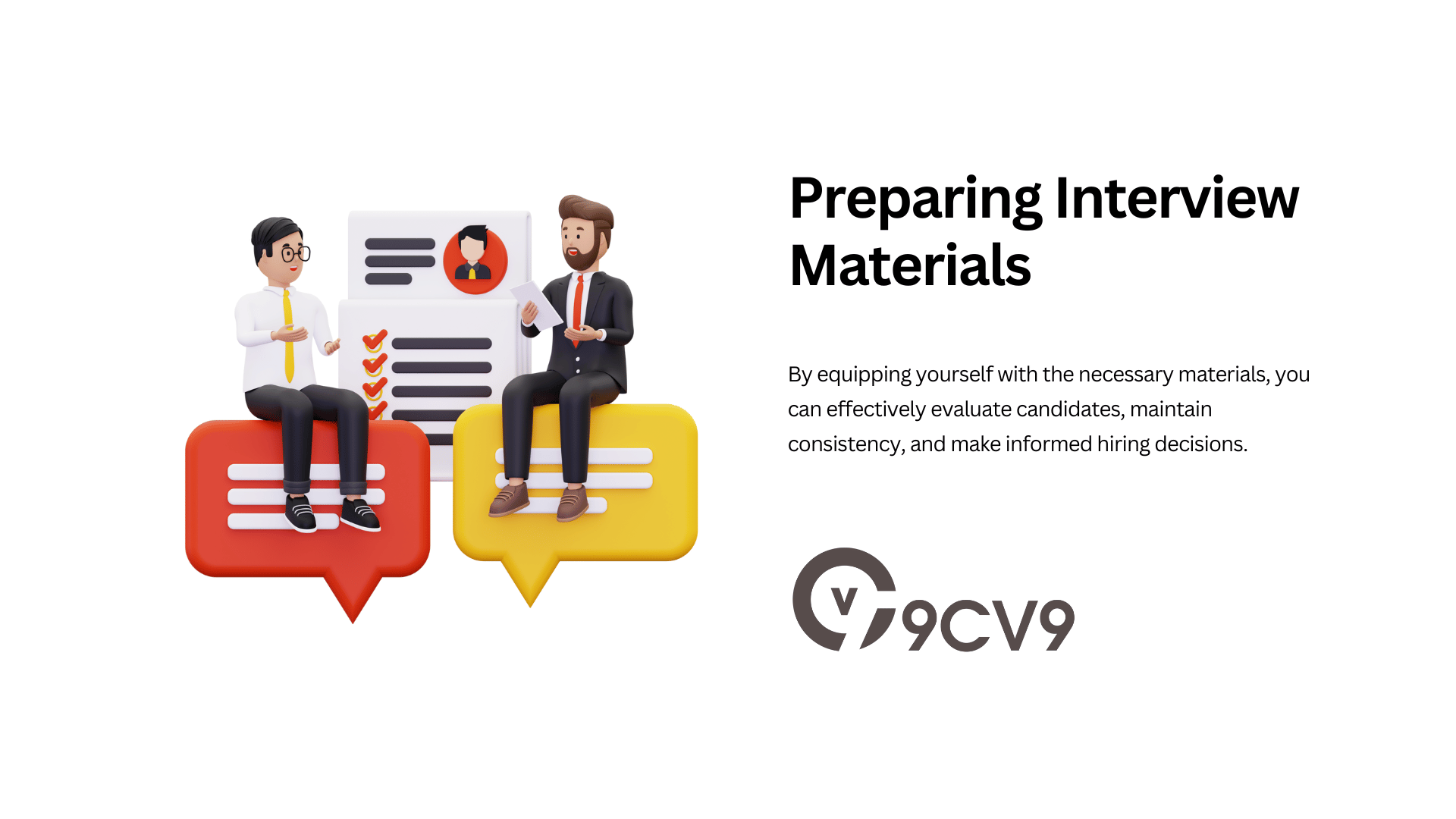
Preparing interview materials is an essential step in ensuring a well-structured and organized interview process as a recruiter.
By equipping yourself with the necessary materials, you can effectively evaluate candidates, maintain consistency, and make informed hiring decisions.
In this section, we will explore key interview materials to prepare and provide actionable tips to optimize your preparation process.
I. Job Description and Candidate Profiles
One of the foundational interview materials is a comprehensive job description that outlines the role’s responsibilities, required skills, and desired qualifications.
Additionally, having candidate profiles on hand allows you to reference candidates’ backgrounds and experiences during the interview. Consider the following strategies:
- Updated job description: Ensure that the job description accurately reflects the current requirements and expectations of the role. It should serve as a reference point to assess candidates’ suitability and guide the interview process.
Example: Include specific details about the job title, key responsibilities, required qualifications, and desired skills and experience. Use bullet points and concise language to make the information easily digestible for interviewers.
- Candidate profiles: Compile candidate profiles that include their resumes, cover letters, and any additional materials they submitted during the application process. This enables interviewers to familiarize themselves with the candidates’ backgrounds and tailor their questions accordingly.
Example: Create a folder or digital repository where you store candidate profiles. Organize them in a systematic manner, such as alphabetically or by interview date, to facilitate easy access during the interview process.
II. Interview Guides and Questions
Preparing interview guides and questions helps maintain consistency across interviews, ensures that all relevant areas are covered, and provides a framework for evaluating candidates effectively.
Consider the following strategies:
- Interview guide: Develop an interview guide that outlines the structure and flow of the interview. This guide can serve as a roadmap for interviewers, ensuring that they cover the necessary topics and gather the desired information from candidates.
Example: Structure the interview guide into sections, such as introduction, behavioral questions, technical skills assessment, and conclusion. Provide a brief overview of each section and specify the objectives and desired outcomes.
- Behavioral and situational questions: Prepare a list of behavioral and situational questions that align with the job requirements and competencies. These types of questions help assess candidates’ past experiences and problem-solving skills.
Example: “Tell me about a time when you faced a challenging situation at work and how you resolved it.” or “Describe a situation where you had to work collaboratively in a team to achieve a common goal. What was your role, and what was the outcome?”
- Technical and role-specific questions: If the role requires specific technical skills or knowledge, include relevant technical or role-specific questions in your interview materials. These questions help assess candidates’ proficiency in areas directly related to the job.
Example: “What programming languages are you most comfortable working with, and how have you applied them in previous projects?” or “Can you explain the key principles of marketing analytics and how you have utilized them in your previous role?”
III. Evaluation Criteria and Scorecards
Establishing clear evaluation criteria and providing scorecards or rating scales helps ensure a fair and consistent assessment of candidates’ performance.
This enables interviewers to evaluate candidates objectively and make informed hiring decisions.
Consider the following strategies:
- Evaluation criteria: Define the specific criteria on which candidates will be evaluated during the interview process. This could include attributes such as technical skills, communication skills, problem-solving abilities, cultural fit, and potential for growth.
Example: Create a document that outlines the evaluation criteria with clear descriptions and benchmarks for each criterion. This helps interviewers align their assessments and provides a framework for comparing candidates.
- Rating scales or scorecards: Develop rating scales or scorecards that interviewers can use to rate candidates’ performance based on the established evaluation criteria. This provides a standardized method for assessing candidates and facilitates meaningful comparisons.
Example: Create a scorecard that includes a rating scale, such as a numerical scale or a set of descriptive performance levels (e.g., excellent, good, fair, poor), for each evaluation criterion. Include space for interviewers to provide comments or additional notes.
IV. Additional Materials and Resources
In addition to the core interview materials mentioned above, consider including any additional materials or resources that could enhance the interview process.
These materials can provide valuable insights or assist interviewers in evaluating candidates effectively. Consider the following:
- Case studies or work samples: If relevant to the role, provide case studies or work samples for candidates to review and discuss during the interview. This allows interviewers to assess candidates’ problem-solving abilities and their approach to real-world scenarios.
Example: Share a case study that presents a typical challenge or project related to the role. Ask candidates to analyze the situation, propose potential solutions, and explain their thought process.
- Interviewer instructions and guidelines: Offer interviewers specific instructions and guidelines on how to conduct the interview and evaluate candidates. This ensures consistency and clarity in the assessment process.
Example: Provide interviewers with a document that outlines their roles and responsibilities, guidelines for conducting effective interviews, and instructions for completing the evaluation forms or scorecards.
- Company and culture information: Provide interviewers with information about the company’s culture, values, and mission. This helps interviewers assess candidates’ alignment with the organization’s culture and determine their potential fit within the team.
Example: Create a document or presentation that highlights the company’s mission, values, and key cultural aspects. Share insights into the company’s work environment, team dynamics, and any unique aspects of the organization’s culture.
By diligently preparing interview materials, you can streamline the interview process, foster consistency in evaluations, and ensure that all relevant aspects are covered during the interviews.
In the next section, we will delve into effective interview techniques and strategies to elicit valuable information from candidates.
Stay tuned for expert tips on conducting impactful interviews.
7. Providing Interview Support
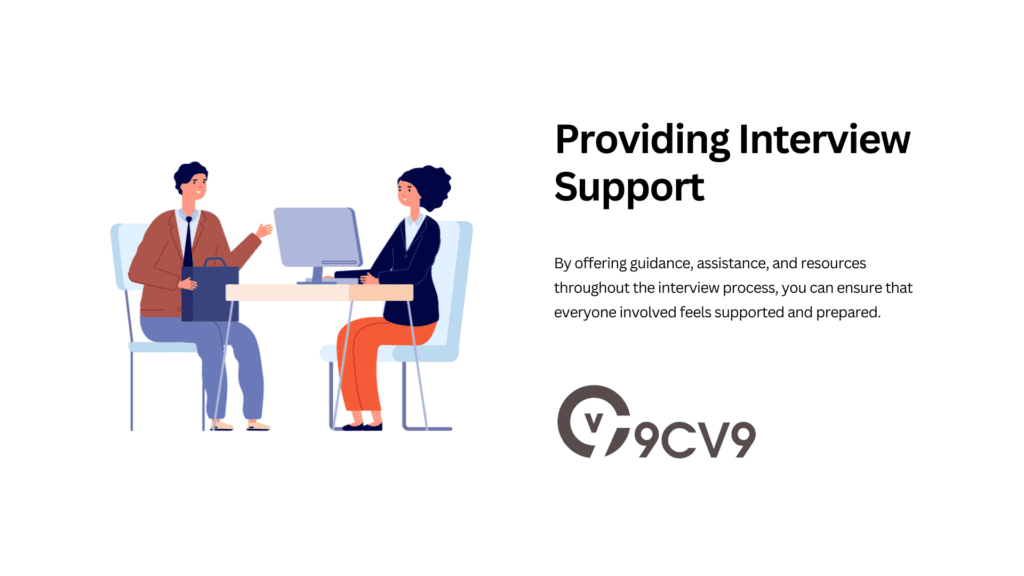
As a recruiter, providing interview support is crucial for creating a positive and professional experience for both candidates and interviewers.
By offering guidance, assistance, and resources throughout the interview process, you can ensure that everyone involved feels supported and prepared.
In this section, we will explore effective strategies for providing interview support and offer actionable tips to optimize your support efforts.
I. Pre-Interview Support
- Interview preparation materials: Offer candidates comprehensive interview preparation materials to help them feel confident and prepared. This can include information about the interview format, common interview questions, and tips for success.
Example: Create a document or webpage that provides candidates with an overview of the interview process, sample questions, and suggestions for effective interview preparation techniques such as researching the company, practicing responses, and showcasing relevant skills and experiences.
- Scheduling assistance: Assist candidates in scheduling their interviews by offering flexible options and accommodating their availability as much as possible. Clear communication and prompt responses to scheduling inquiries can alleviate stress and demonstrate your commitment to a smooth interview experience.
Example: Provide candidates with a range of available time slots or utilize scheduling software that allows them to select their preferred interview time. Be responsive to scheduling inquiries and offer alternative options when necessary.
- Technical support for virtual interviews: If conducting virtual interviews, ensure that candidates have the necessary technical information and support. Offer guidance on using video conferencing platforms and troubleshoot any potential issues in advance.
Example: Send candidates detailed instructions on how to join the virtual interview, including the platform, meeting ID, and any necessary login credentials. Provide a contact person or a dedicated email address for technical support in case candidates encounter difficulties.
II. During the Interview Support
- Clear communication and expectations: Set clear expectations with both candidates and interviewers regarding the interview process, timelines, and any specific requirements. Ensure that everyone understands the format of the interview and what to expect during the interaction.
Example: Send a detailed email to candidates prior to the interview, outlining the interview format, estimated duration, and any additional instructions or materials they need to prepare. Similarly, communicate with interviewers about their roles and responsibilities during the interview.
- Prompt and responsive communication: Be available and responsive to candidates’ and interviewers’ inquiries or concerns during the interview process. Timely and efficient communication helps build trust, fosters a positive experience, and demonstrates professionalism.
Example: Respond to candidates’ emails or messages promptly, even if it’s just to acknowledge receipt of their inquiry and provide a timeline for a more detailed response. Address any concerns or questions interviewers may have to ensure they feel supported.
- Interview logistics assistance: Provide candidates and interviewers with all necessary logistical information to ensure a smooth interview experience. This includes details such as the interview location (if applicable), parking instructions, and any specific requirements or arrangements.
Example: Share a comprehensive email or document with candidates, providing all relevant logistical information, such as the interview venue address, parking options, public transportation details, and any additional instructions. Similarly, offer interviewers clear guidance on the interview location and any required materials.
III. Post-Interview Support
- Candidate feedback and updates: Keep candidates informed about the interview outcomes and provide constructive feedback whenever possible. This helps candidates understand their strengths and areas for improvement and fosters a positive candidate experience.
Example: Send a personalized email to candidates, thanking them for their time and effort in attending the interview. Provide general feedback on their performance, highlighting areas of strength and offering suggestions for development, if applicable.
- Interviewer debriefing and support: After the interviews, offer support to interviewers by providing a platform for debriefing and discussing the candidates’ performances. This allows interviewers to share insights, compare notes, and collectively make informed hiring decisions.
Example: Schedule a debriefing meeting or create an online platform where interviewers can share their impressions, discuss the candidates’ qualifications, and provide input on the selection process. Encourage open and honest communication to facilitate a comprehensive evaluation.
- Continued guidance and resources: Offer ongoing support and resources to both candidates and interviewers beyond the interview stage. This can include providing information on next steps in the hiring process, answering follow-up questions, or sharing additional materials that may be helpful.
Example: Send candidates an email outlining the next steps in the hiring process, such as when they can expect to hear back or whether there will be additional rounds of interviews. Provide interviewers with resources on effective interviewing techniques, diversity and inclusion guidelines, or any updates on company policies.
By providing comprehensive interview support, you can create a positive and professional experience for candidates and interviewers alike.
This fosters a favorable impression of your organization and contributes to a strong employer brand.
In the next section, we will discuss the crucial step of evaluating candidates’ performance and making informed hiring decisions.
Stay tuned for valuable insights on candidate assessment and selection.
8. Follow-up and Feedback
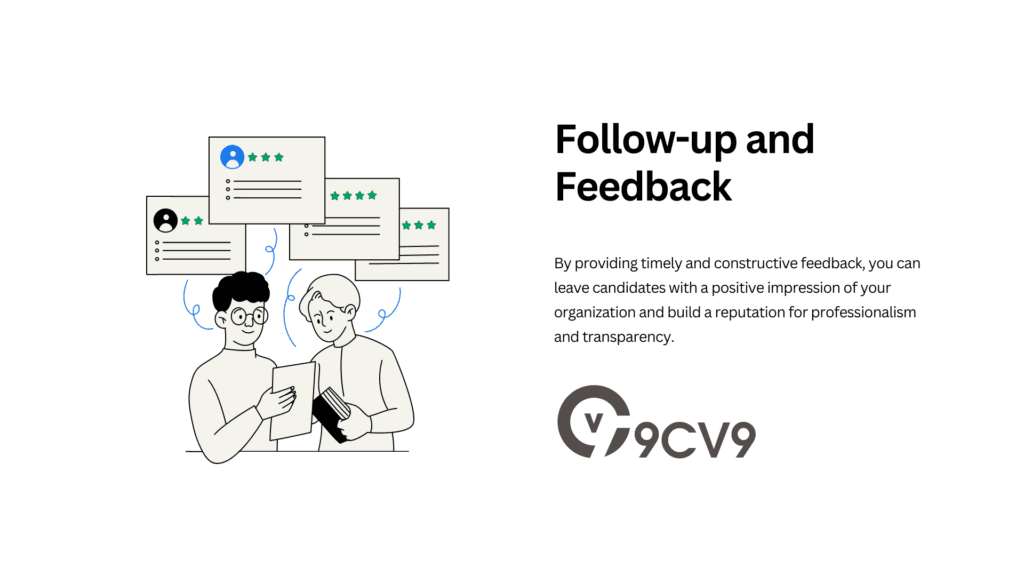
The follow-up and feedback stage of the interview process is essential for maintaining positive candidate experiences, fostering communication, and closing the loop with candidates.
By providing timely and constructive feedback, you can leave candidates with a positive impression of your organization and build a reputation for professionalism and transparency.
In this section, we will explore effective strategies for follow-up and feedback and offer actionable tips to optimize this stage of the interview process.
I. Prompt Follow-Up
After conducting interviews, it is crucial to follow up with candidates in a timely manner.
Prompt follow-up demonstrates respect for candidates’ time and effort, and it keeps them informed about the progress of their application.
Consider the following strategies:
- Thank you email or note: Send a personalized thank you email or note to candidates within 24 to 48 hours after their interview. Express appreciation for their participation and reiterate your interest in their candidacy.
Example: “Dear [Candidate’s Name],
Thank you for taking the time to interview with our company for the [Job Title] position. We appreciate your interest in our organization and enjoyed discussing your qualifications and experiences during the interview.
We wanted to express our gratitude for your time and effort in attending the interview. We will be reviewing all candidates and will be in touch with you regarding the next steps in the hiring process.
Once again, thank you for your interest in our company.
Best regards, [Your Name]”
- Set expectations for next steps: Provide candidates with an overview of the next steps in the hiring process, including timelines and potential follow-up actions. This keeps candidates informed and helps manage their expectations.
Example: “Based on our interview process timeline, we expect to reach a decision regarding the [Job Title] position within the next two weeks. You will be notified by email regarding the outcome of your application. If you have any further questions or need additional information, please feel free to reach out to us at [contact email or phone number].”
II. Constructive Feedback
Providing candidates with constructive feedback is a valuable practice that helps them understand their strengths and areas for improvement.
It demonstrates your commitment to their professional growth and can leave a positive impression even if they were not selected for the role.
Consider the following strategies:
- Focus on specific observations: When offering feedback, be specific and provide examples of the candidate’s performance during the interview. Highlight their strengths and areas where they excelled, as well as areas where they may need further development.
Example: “During the interview, you demonstrated strong communication skills and a solid understanding of the industry trends. Your ability to articulate your experiences and provide relevant examples was impressive and showcased your expertise in [specific area].”
- Offer constructive criticism: While it is important to highlight areas of improvement, do so in a constructive and supportive manner. Provide actionable suggestions for how the candidate can enhance their skills or address any weaknesses.
Example: “One area where you may consider further development is [specific skill or area]. It would be beneficial to focus on [specific action or approach] to strengthen your abilities in this area. Additionally, exploring [relevant resource or training opportunity] could help you expand your knowledge and expertise.”
- Maintain a positive and encouraging tone: Feedback should always be delivered in a positive and encouraging manner. Emphasize the candidate’s strengths and accomplishments to balance any areas of improvement. This approach helps maintain candidates’ motivation and confidence.
Example: “Overall, we were impressed with your qualifications and the experiences you shared during the interview. You exhibited a strong passion for [relevant field] and demonstrated the potential to make a valuable contribution to our organization.”
III. Open Communication Channels
Establishing open communication channels with candidates is essential for providing ongoing support and addressing any questions or concerns they may have.
Encourage candidates to reach out to you if they have additional inquiries or require further information.
Consider the following strategies:
- Responsive email communication: Be responsive to candidates’ emails or messages, ensuring that you acknowledge their inquiries and provide timely and relevant responses. This demonstrates your commitment to open communication and professionalism.
Example: “Thank you for your email and for reaching out with your questions. We appreciate your interest in our company, and we are happy to provide the information you requested. Please find detailed answers to your questions below…”
- Contact information availability: Provide candidates with a dedicated email address or contact person they can reach out to for any follow-up queries or additional information. Make sure the contact information is easily accessible and clearly communicated.
Example: “If you have any further questions or need additional information, please do not hesitate to contact us at [contact email or phone number]. Our team is here to assist you and provide the support you need throughout the hiring process.”
- Post-interview surveys or feedback forms: Consider implementing post-interview surveys or feedback forms to gather candidates’ feedback on their interview experience. This allows you to gather valuable insights for process improvement and demonstrates your commitment to continuous enhancement.
Example: “We value your feedback and would appreciate if you could take a few minutes to complete a brief survey about your interview experience. Your input is crucial for us to enhance our processes and ensure a positive candidate experience. You can access the survey by following this link [insert survey link].”
By prioritizing prompt follow-up, providing constructive feedback, and maintaining open communication channels, you can establish a positive candidate experience and reinforce your organization’s commitment to professionalism and transparency.
Conclusion
Congratulations.
You have now reached the end of “The Ultimate Guide: How to Set Up an Interview as a Recruiter.”
Throughout this comprehensive guide, we have explored the essential steps and strategies for successfully setting up interviews as a recruiter.
From preparing for the interview setup to providing interview support, arranging logistics, coordinating with interviewers, preparing interview materials, and offering follow-up and feedback, we have covered every aspect to help you optimize your interview process.
By implementing the best practices outlined in this guide, you can streamline your interview process, enhance candidate experiences, and ultimately make informed hiring decisions.
Let’s recap some key takeaways:
- Preparing for the Interview Setup: Take the time to thoroughly understand the role and requirements, establish evaluation criteria, and create a structured interview plan.
- Scheduling the Interview: Be flexible, consider candidates’ availability, and utilize scheduling tools or software to simplify the process.
- Communicating with Candidates: Maintain clear and prompt communication with candidates, setting expectations and providing necessary information throughout the process.
- Arranging the Interview Logistics: Pay attention to logistical details, such as interview location, parking, and any special accommodations required.
- Coordinating with Interviewers and Panel Members: Foster effective communication with interviewers, provide clear guidelines, and facilitate debriefing sessions to gather collective insights.
- Preparing Interview Materials: Create comprehensive interview materials, including job descriptions, evaluation criteria, and interview questions, to ensure consistency and fairness in the evaluation process.
- Providing Interview Support: Offer support to candidates and interviewers through pre-interview guidance, technical assistance, and ongoing communication.
- Follow-up and Feedback: Promptly follow up with candidates, offering constructive feedback and maintaining open communication channels.
By following these guidelines, you can create a positive candidate experience, attract top talent, and make well-informed hiring decisions that align with your organization’s goals and values.
Remember, the interview process is not just an opportunity to evaluate candidates; it is also a chance to showcase your company’s professionalism and commitment to a fair and transparent recruitment process.
A positive experience, even for candidates who may not ultimately be selected, can leave a lasting impression and contribute to your organization’s employer brand.
Continuously seek feedback from candidates, interviewers, and other stakeholders to identify areas for improvement in your interview process.
Stay updated with emerging trends and best practices in recruitment to adapt and refine your approach over time.
Thank you for joining us on this journey through “The Ultimate Guide: How to Set Up an Interview as a Recruiter.”
We hope that this guide has provided you with valuable insights, practical tips, and actionable strategies to optimize your interview process.
Best of luck in your future recruitment endeavors, and may you find the perfect candidates who will contribute to the success of your organization.
If your company needs HR, hiring, or corporate services, you can use 9cv9 hiring and recruitment services. Book a consultation slot here, or send over an email to [email protected].
If you find this article useful, why not share it with your hiring manager and C-level suite friends and also leave a nice comment below?
We, at the 9cv9 Research Team, strive to bring the latest and most meaningful data, guides, and statistics to your doorstep.
To get access to top-quality guides, click over to 9cv9 Blog.
People Also Ask
How do you make an interview process?
To create an interview process: 1. Define job requirements, 2. Prepare interview questions, 3. Establish evaluation criteria, 4. Coordinate scheduling, 5. Provide pre-interview guidance, 6. Conduct interviews, 7. Evaluate candidates, 8. Provide feedback, 9. Follow up, 10. Continuously improve.
What do you say when calling to set up an interview?
Hello [Candidate’s Name], this is [Your Name] from [Your Company]. I’m calling to schedule an interview for the [Job Title] position. Are you available [suggest specific dates and times] for a [phone/in-person] interview? We look forward to meeting you and discussing your qualifications further.
Can I call to set up an interview?
Yes, calling to set up an interview is a common and effective approach. It allows for direct communication, immediate clarification, and the opportunity to establish a personal connection with the candidate.




























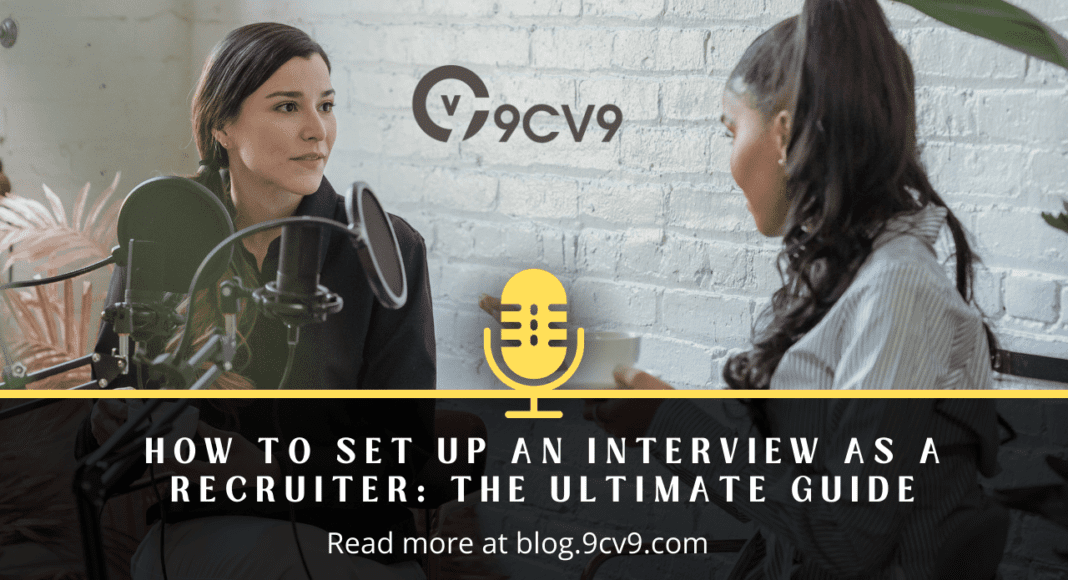


![Writing A Good CV [6 Tips To Improve Your CV] 6 Tips To Improve Your CV](https://blog.9cv9.com/wp-content/uploads/2020/06/2020-06-02-2-100x70.png)


